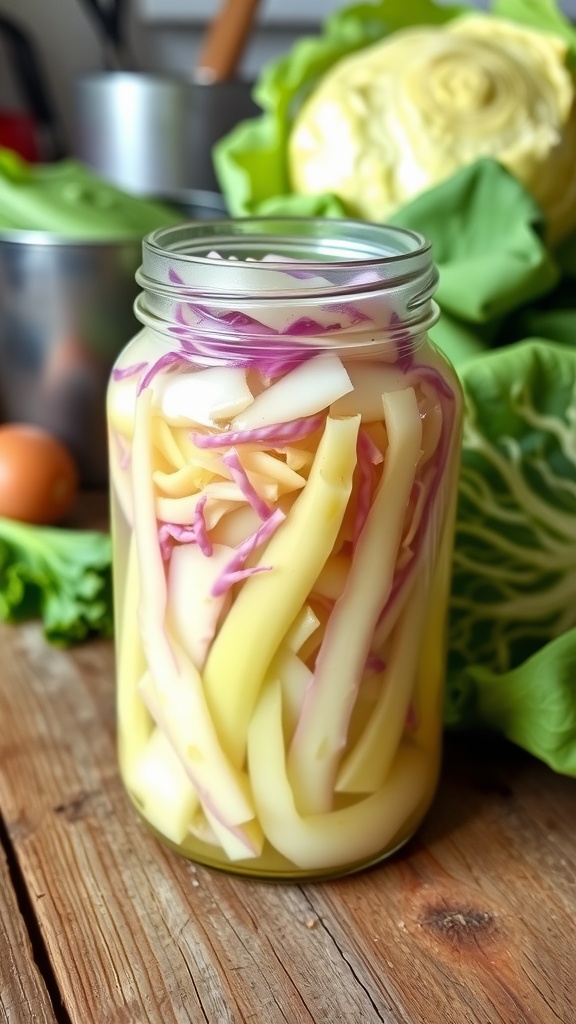Have you ever tasted the crisp, tangy goodness of fermented cabbage? This recipe brings that delightful crunch and sour flavor straight to your kitchen. Fermented cabbage, often known as sauerkraut, is not only a delicious condiment but also packed with probiotics that are great for your gut health.
Making your own fermented cabbage is surprisingly simple and requires just a few ingredients. You’ll be amazed at how a humble vegetable can transform into a zesty and refreshing side dish, perfect for salads, sandwiches, or as a topping for sausages. Plus, you can customize the flavor by adding spices or other vegetables.
This tangy treat is not just tasty; it’s a great way to preserve cabbage and reduce food waste. Say goodbye to bland and hello to a burst of flavor that will elevate any meal!
The Art of Fermentation
Fermentation is a time-honored technique that transforms simple ingredients into complex flavors and textures.
This process not only enhances taste but also boosts nutritional value, especially when it comes to vegetables like cabbage.
Using just a few basic ingredients, you can create a tangy, probiotic-rich delight that is as beneficial as it is delicious.
The Beauty of Fermented Cabbage
Imagine a jar filled with vibrant hues of pale green and deep purple cabbage, glistening with its tangy brine.
The visual appeal of fermented cabbage is just one aspect of its charm.
The combination of colors is captivating and hints at the burst of flavor waiting inside the jar.
The fermentation process not only alters the cabbage’s appearance but also deepens its flavor profile, turning it into a zesty accompaniment for a variety of dishes.
This dish stands out as a nutritious staple that can elevate meals while providing gut-friendly probiotics.
Simple Ingredients, Incredible Flavor
The beauty of making fermented cabbage lies in its simplicity.
With just cabbage and sea salt as the foundation, you can customize the taste with optional spices like caraway seeds or garlic.
This flexibility allows for a blend of flavors that can suit any palate.
Choosing quality ingredients is key – fresh, organic cabbage will yield the best results.
The careful balance of salt is essential, as it encourages the release of natural juices while preventing spoilage.
The Fermentation Process
Preparing the cabbage for fermentation is a straightforward process that requires minimal effort.
Begin by removing the outer leaves and finely shredding the cabbage.
Massaging the salt into the cabbage helps to draw out moisture, creating a brine that will protect the cabbage during fermentation.
Once packed into a jar, the cabbage needs time to ferment.
Storing it in a cool, dark place allows beneficial bacteria to develop, resulting in that signature tangy flavor.
Regularly tasting the ferment as it progresses ensures a personal touch, allowing you to stop it at your preferred level of sourness.
Fermented cabbage is incredibly versatile and can enhance countless dishes.
Use it as a crunchy topping for tacos, add it to sandwiches for an extra layer of flavor, or serve it alongside meats to complement hearty meals.
Its tartness can balance rich dishes and add depth to salads.
Moreover, enjoying fermented cabbage regularly contributes to a healthy gut microbiome, making it a wise choice for both taste and health.
It’s not just a side dish; it’s a way to incorporate probiotics into your diet effortlessly.
Making your own fermented cabbage connects you to culinary traditions that span centuries.
This method of preservation not only reduces food waste but also allows you to enjoy the unique flavors of fermented food right at home.
As you experiment with spices and fermentation times, you’re participating in a time-honored practice that has stood the test of time.
So, whether it’s enjoyed straight from the jar or as a flavorful addition to your meals, fermented cabbage is a delightful and healthful creation.
The satisfaction of making it yourself adds an element of pride to a simple vegetable, turning it into a vibrant culinary masterpiece.
Easy and Delicious Fermented Cabbage
This fermented cabbage has a crisp texture and a tart, tangy flavor that complements a variety of dishes. The natural fermentation process enhances the cabbage’s flavor while promoting gut health, making it a nutritious addition to your meals.
Ingredients
- 1 medium head of cabbage, finely shredded
- 1 tablespoon sea salt
- Optional spices: caraway seeds, garlic, or peppercorns
Instructions
- Prepare the Cabbage: Remove the outer leaves of the cabbage and cut it into quarters. Finely shred the cabbage using a knife or a mandoline.
- Mix with Salt: In a large bowl, combine the shredded cabbage with the sea salt. Massage the salt into the cabbage for about 5-10 minutes until it starts to release liquid.
- Pack into Jar: Transfer the salted cabbage into a clean glass jar, packing it down firmly to remove any air pockets and to ensure the cabbage is submerged in its own brine.
- Ferment: Seal the jar with a lid and let it sit at room temperature, away from direct sunlight, for about 1-4 weeks. Taste weekly until it reaches your desired level of tanginess.
- Store: Once fermented, transfer the jar to the refrigerator to slow down the fermentation process. It can be enjoyed cold or as a side dish for various meals.
Cook and Prep Times
- Prep Time: 15 minutes
- Fermentation Time: 1 to 4 weeks
- Total Time: Approximately 1 to 4 weeks
- Servings: Makes about 1 quart
- Calories: 25kcal per serving
- Fat: 0g
- Protein: 1g
- Carbohydrates: 5g
Source link
Admin
#Tangy #Fermented #Cabbage #Recipe
